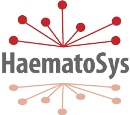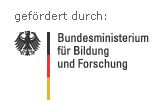HaematoSys
Systembiologie der Hämatopoese und hämatopoetischer Neoplasien
Subproject 1 ¿ Model of pluripotent hematopoietic stem cells (HSC)
Applicants: Ingo Röder (IR); Michael Cross (MC); Andreas Trumpp (AT); Tilo Pompe (TP)
Associated partners (providing methods, data, consultation): K. Moore, C. Eaves, C.Müller-Sieburg
Background and own contributions: Building on a long-lasting experience on modelling stem cell organisation in different tissues [e.g. 1.1 – 1.6] we developed a stochastic individual cell-based model (IBM) of HSC organisation, based on the new concept of phenotypic and functional reversibility [1.7, 1.8]. This model was shown to consistently explain a broad range of phenomena in vitro and in vivo. The new paradigm was to explain stem cell organisation as a self-organising process with the potential of individual cells to reversibly change their functional status. It has been extensively discussed in the literature and within a series of international workshops organised by our group and it is, meanwhile, accepted by a considerable number of leading stem cell biologists.
Objective: It is our objective to refine and extend the current stochastic IBM of HSC organisation, aiming at an explicit description of regulatory mechanisms underlying the cell kinetics (cell cycle activation/silencing), the cell-microenvironmental (stem cell–niche) interactions, and the lineage specification (erythro-, granulo-, and thrombopoietic lineages) at the individual cell level. Using a series of specific experiments, we generate a consistent set of quantitative data, providing the basis to derive model assumptions, determine parameters, and validate predictions.
Available data: Long-term labelling data of HSC (AT, Moore); clonal repopulation data (Eaves, Müller-Sieburg); gene expression time series on differentiating HSCs (EuroSyStem).
Working program: Modelling cell kinetics and cell – microenvironmental interactions. To quantitatively describe regulatory mechanisms underlying cell cycle activation/silencing and cell-microenvironmental interactions of individual HSCs (i.e. determine model assumptions / parameters) it is necessary to analyse HSC on the cell population and on the single cell level. Time course measurements under various perturbations are inevitable to identify and quantify the cellular dynamics. To identify and distinguish the effects of cytokines, stroma and metabolic conditions the properties of HSCs (using the murine FDCP-Mix cell line and purified CD34+CD38- human bone marrow cells) will be investigated in vitro under a range of culture conditions amenable to detailed analysis: stroma-dependent/free cultures in which cytokine dependence will be tested under defined metabolic conditions (pO2, glucose, osmolarity) (MC). These analyses will be complemented by long-term label uptake/dilution experiments. Data on BrdU and histone H2B-GFP labelling, including functional testing of cells with different label retention properties, which provides quantitative information on the balance between HSC dormancy and cycling, is provided by AT and K. Moore. This data will particularly be used to validate the model assumptions that the proliferative status of HSCs is a reversible property. Additionally we will analyse single cell fates in these assays using time lapse video microscopy (TP). Using algorithms for automatic cell tracking and the analysis of cellular genealogies (currently developed in our group within the EU consortium “EuroSyStem”, IR), we will reconstruct the cellular genealogies of individual HSC clones with respect to cycling activity and cell-cell / cell-microenvironment interaction. Besides quantitative information of the overall cell turnover, these experiments provide estimates for the distribution of cell cycle times, the contact rates between HSC and stroma cell, and their dynamic dependence on variable culture conditions. Therefore, the experiments allow the precise testing of model predictions on the cell population and on the single cell level.
Lineage specification. To validate model assumptions and to refine the current model with respect to cell lineage choice, we will investigate haematopoietic lineage specification within the context of the murine FDCP-Mix cell line. This system is optimal for testing particular model assumptions/predictions, because cells can be kept in an undifferentiated state as well as directed into different lineages in a controlled manner. Applying systematic perturbation protocols, we will determine overall lineage contributions, correlations of lineage fate and clonal origin, and the dose-response characteristics of lineage specific growth factors. To arrive at a quantitatively correct model description all experiments will again be assessed on the cell population (MC) and the single cell level (TP). Beyond this, we will adopt the model to explain observed biased lineage contributions of individual stem cell clones on the basis of available data on clonally repopulated mice (Eaves, Müller-Sieburg). This part of the SP1 is complementary to our activities in the EU consortium “EuroSyStems” where we model lineage specification in HSC by an intra-cellular transcription factor network based on time series gene expression measurement (IR).

